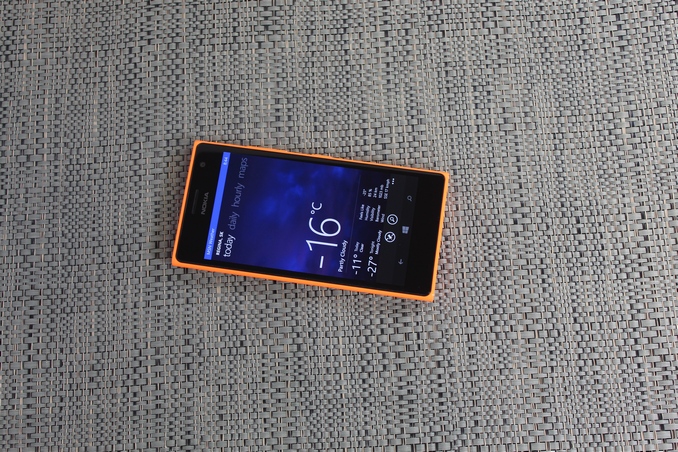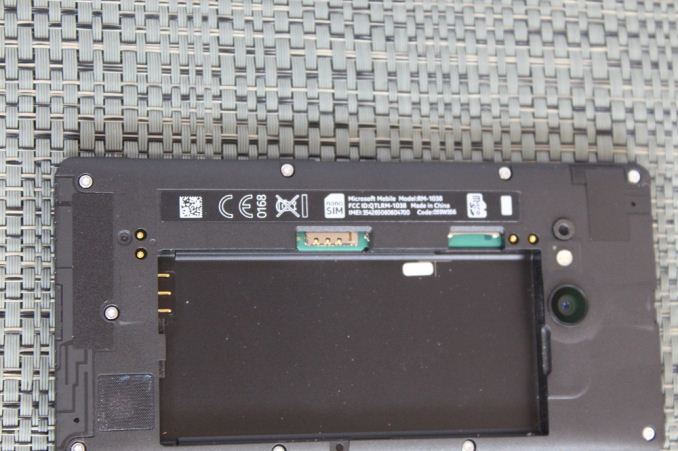Nokia Lumia 735 Review
by Brett Howse on February 3, 2015 6:00 AM EST- Posted in
- Smartphones
- Microsoft
- Nokia
- Lumia

Back in September, Microsoft launched what would be the last two Nokia branded Lumias. The Lumia 830 was announced as an affordable flagship, and we reviewed the 830 back in November. The Lumia 730 and 735 were launched with a different feature set, a lower price, and a higher resolution front facing camera. Microsoft announced them as “built for Skype calls and selfies” with the inclusion of the five megapixel front facing camera and put the package in a smaller, lighter body. It was launched with four colors, with the 730 being a dual SIM version and the 735 is a single SIM with LTE capabilities.
Right after our Lumia 830 review, Microsoft asked if I would like to review the 735 as well. Although many of the internals are similar or identical to the 830 and 630, there is enough different that this is really a unique phone in the Lumia range. It lacks the PureView branded camera system, but still has a good camera. The OLED display is 720p, which is a step up from the lower cost 630, and the same resolution as the 830, but in a slightly smaller screen size. At 4.7”, this is the only Lumia available at this size.
The Lumia 830 tried to put a higher end package together with the metal frame, 5” display, and a PureView 10 MP camera with OIS into a less expensive price bracket. Although the SoC in the 830 is only a Snapdragon 400, it is overall a great phone which is hampered only by its price. The 735 steps the price down further and packages the phone in a more traditional Lumia style with a fully polycarbonate body.
| Nokia Lumia 735 | Nokia Lumia 830 | |
| SoC | MSM8926 1.2 GHz Snapdragon 400 | MSM8926 1.2 GHz Snapdragon 400 |
| RAM/NAND | 1 GB LPDDR2, 8 GB NAND + microSD 128 GB |
1 GB LPDDR2, 16 GB NAND + microSD 128 GB |
| Display | 4.7” 1280x720 ClearBlack OLED Corning Gorilla Glass 3 |
5.0” 1280x720 IPS ClearBlack LCD Corning Gorilla Glass 3 |
| Network | GSM/GPRS/EDGE/HSPA/LTE up to 150 Mbps |
GSM/GPRS/EDGE/HSPA/LTE up to 150 Mbps |
| Dimensions | 134.7 x 68.5 x 8.9 (mm) | 139.4 x 70.7 x 8.5 (mm) |
| Weight | 134.3 grams | 150 grams |
| Rear Camera | 6.7MP, 1.4 µm pixels, 1/3.4" 16x9 CMOS, f/1.9, 26 mm focal length, LED Flash |
10MP, 1.1 µm pixels, 1/3.4" 16x9 CMOS, f/2.2, 26 mm focal length, LED Flash |
| Front Camera | 5MP wide angle, f/2.4, 1920x1080 video resolution |
0.9MP wide angle, f/2.4, 1280x720 video resolution |
| Battery | 2200 mAh, 3.8 V, 7.04 Wh | BV-L4A 2200 mAh, 3.8 V, 7.04 Wh |
| OS | Windows Phone 8.1 with Lumia Denim Firmware |
Windows Phone 8.1 with Lumia Denim Firmware |
| Connectivity | 802.11 b/g/n (2.4 GHz) + BT 4.0, USB2.0, DLNA, FM Radio |
802.11 a/b/g/n + BT 4.0, USB2.0, DLNA, FM Radio |
| Location Technologies |
Cellular and Wi-Fi network positioning, A-GPS, A-GLONASS, BeiDou |
Cellular and Wi-Fi network positioning, A-GPS, A-GLONASS, BeiDou |
| SIM Size | Nano SIM, Dual-SIM HSPA on Lumia 730 |
Nano SIM |
Internally, it is very similar to the Lumia 830. The Snapdragon 400 MSM8926 provides the quad-core Cortex A7 at 1.2 GHz, as well as the LTE modem. Memory is identical at 1 GB of LPDDR2, which opens the entire range of Windows Store apps to this device. The OLED display also features ClearBlack, which is a polarizing filter to keep refractions and reflections from outside lighting to a minimum. Storage is less than the Lumia 830, with only 8 GB of internal NAND available. A micro SD card slot allows an additional 128 GB to be added, and Windows Phone’s Storage Sense app makes it easy to control where your data gets stored. The latest update to Windows Phone also allows future software updates to be staged to the SD card, making the 8 GB not as much of a detriment as on other platforms.
One rather large omission, which is available on the Lumia 830, is Glance screen support. Every Lumia should have Glance, as it is one of the best features. Because this one does not, it is a big knock against it, especially when moving from an older Lumia with Glance support.











64 Comments
View All Comments
gijames1225 - Tuesday, February 3, 2015 - link
What's the rationale for when to include and when not to include iPhones in the comparisons? No iPhone was compared in the battery life charts, but it's there in a lot of the other charts.melgross - Tuesday, February 3, 2015 - link
Particularly as it was said that the testing app is now compatable across systems.Brett Howse - Tuesday, February 3, 2015 - link
We pull our data from our online database, and the iPhone would not be included if that particular test was not run on it. GFXBench just updated to this version recently on iOS (by recently I mean since our initial review)gijames1225 - Tuesday, February 3, 2015 - link
Cool, thanks for the explanation.hlovatt - Tuesday, February 3, 2015 - link
There was some comparison against iPhone5c, but inconsistent and missing for performance. So the review was a bit disappointing overall :(Brett Howse - Tuesday, February 3, 2015 - link
Our benchmarks evolve over time, and as new versions come out, we migrate towards them. The 5c was reviewed a while ago, so it would not have been run on benchmarks that came out after its launch, but price wise is still similar to the 735 so I included it where I could. If you want to compare the 735 to any other iPhones, I mentioned in the article that we have a great online tool for that called Bench which you can find a link to at the top of our main page.hlovatt - Tuesday, February 3, 2015 - link
Thanks for your reply. Pity that the newer benchmarks are not available for 5C. I guess that provided that the benchmarks don't continually change this won't be a common problem. Pity in this case, but thanks again for the reply.bullzz - Tuesday, February 3, 2015 - link
@Brett - Great review. in some CPU and GPU benchmarks why does 735 perform 10-30% slower than Moto G. I thought they were using the same socI don't know why anyone would buy this or 830 over Moto G LTE. better performance, better display, better OS. Only upside is battery life but I think MotoG has much better value to it
Daniel Egger - Tuesday, February 3, 2015 - link
Because people typically buy phones for the full package rather than just plain hardware specs? Otherwise neither Motorola nor Microsoft nor Apple would sell any phones...Brett Howse - Tuesday, February 3, 2015 - link
Yes, they are the same SoC. Snapdragon 400 in both. In the web browser tests, Internet Explorer is much slower than Chrome. IE is being replaced though, and the new replacement is already much faster, so on Windows 10, this should be less of an issue.As for the GPU benchmarks, my suspicion is that the video drivers for Adreno are more tuned for Android than they are for Windows Phone with DirectX.